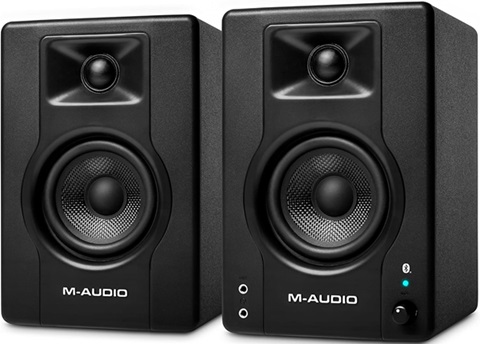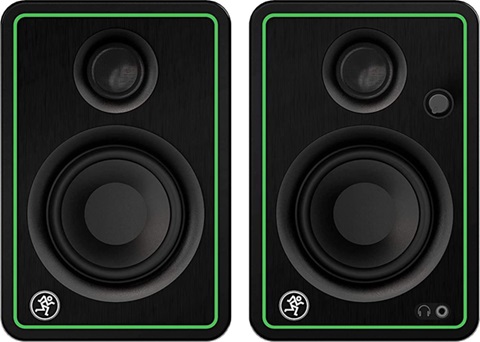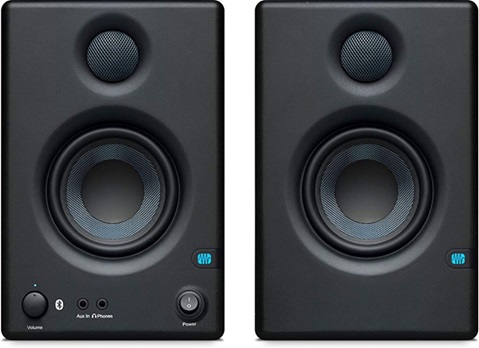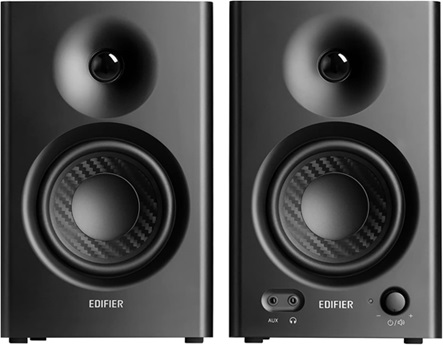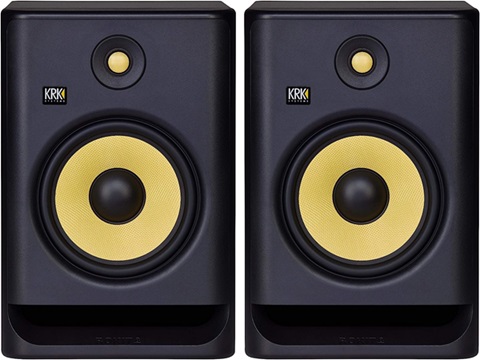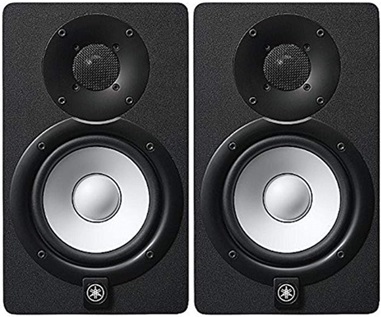Small studio monitors are essential for music producers and audio engineers who work in compact spaces, offering high-quality sound reproduction in a space-saving design. They provide accurate audio feedback, critical for mixing and mastering in tight environments.
- Driver Size: Monitors with driver sizes between 3 and 5 inches were chosen for a good balance of size and sound quality. This size is just right for clear midrange and highs, crucial for accurate monitoring in smaller spaces.
- Connectivity Technology: Our monitors offer both analog and digital connection options. We prefer models with XLR, TRS, and RCA inputs, along with USB and Bluetooth for wireless streaming. This ensures compatibility with various audio sources and setups.
- Power: We aimed for speakers with power outputs ranging from 20W to 50W per speaker, which is ideal for most small studio needs. This range ensures enough volume and headroom for clear sound reproduction without distortion, even at higher volumes.
Our “Buying Guide” covers essential factors like power, frequency response, and amplification type. It also features reviews of top small studio monitors.
Outline
ToggleBest Small Studio Monitors Table
| Best Small Studio Monitors | Woofer Size and Tweeter Size | Connectivity Technology | Buy Now |
|---|---|---|---|
| PreSonus Studio Monitor | 3.5 Inch and 1" | RCA | Check On Amazon |
| Sanyun Studio Monitor | 3.5" and 1" | Auxiliary, USB, Bluetooth 5.0 | Check On Amazon |
| M-Audio Studio Monitors | 3.5" and 1" | Bluetooth | Check On Amazon |
| Mackie Studio Monitors | 3" and 0.75" | Bluetooth | Check On Amazon |
| Presonus Studio Monitors | 3.5" and 1" | Bluetooth | Check On Amazon |
| Edifier Studio Monitors | 4" and 1" | Auxiliary | Check On Amazon |
| JBL Studio Monitor | 5" and 1" | wired | Check On Amazon |
| Alesis Studio Monitor | 5" and 1" | USB | Check On Amazon |
| KRK Studio Monitors | 5" and 1" | - | Check On Amazon |
| Yamaha Studio Monitors | 5" and 1" | XLR | Check On Amazon |
Best Studio Monitors Reviews
1. PreSonus Studio Monitor
Presonus is one of the top brands that comes to mind when discussing audio interfaces, and studio monitors. And for those looking for the perfect studio monitor that is both affordable and great in performance, then the Eris 3.5 is worth every penny.
The monitor’s compact size and sleek design make them perfect for any desk setup. Despite the small size, it delivers an impressive 50 watts of power. This ensures clear and loud audio without distortion.
The Eris 3.5 features woven-composite woofers for tight bass and clear sound. The 1-inch silk-dome tweeters provide superior stereo imaging, offering a wide listening sweet spot. With both RCA and 1/4″ TRS inputs, these monitors are compatible with various audio devices.
For private listening, the front-panel headphone output is convenient. You can fine-tune the audio output to match your room size and preferences using the high- and low-frequency tuning controls. This flexibility makes the Eris 3.5 suitable for different environments, whether on a desk, bookshelf, or next to a turntable.
Specifications:
- Maximum Output Power: 50 Watts
- Connectivity: RCA, Auxiliary, 1/4″ TRS
- Audio Output Mode: Stereo
- Mounting Type: Desktop, Bookshelf
- Woofer Diameter:5 Inches
- Tweeter Diameter: 1 Inch
- Frequency Response: 80 Hz – 20 kHz
- Input Sensitivity: 100 dB SPL
- Power Source: Corded Electric
Pros:
- Exceptional sound quality
- Compact and sleek design
- Easy to set up and use
- Customizable sound tuning
Cons:
- No Bluetooth connectivity
- Slightly bulky for small spaces
2. Sanyun Studio Monitor
When we tested this product versus others on the list, the SW208 speakers from Sanyun were exceptional, making them perfect for those who want clear and immersive audio. They have carbon fiber speaker units and multi-layer voice coil technology. This gives a warm midrange, strong low frequencies, and bright high frequencies.
One great feature of the Sanyun SW208 is its flexibility. It has Bluetooth 5.0, a 24-bit DAC USB connection, and auxiliary inputs. These options let you connect to many devices easily. Whether for music production, gaming, or casual listening, these speakers fit right into your setup.
The SW208 also has treble and bass adjustment knobs. You can customize the sound to your liking. The built-in noise elimination system keeps the speakers quiet when not in use, saving energy and ensuring a peaceful environment.
Specifications:
- Maximum Output Power: 60 Watts
- Connectivity: Auxiliary, USB, Bluetooth 5.0
- Audio Output Mode: Surround, Stereo
- Input Voltage: 240 Volts
- Woofer Diameter: 3 Inches
- Frequency Response: 40 Hz – 20 kHz
- Signal-to-Noise Ratio: 75 dB
- Power Source: AC
- Control Method: Button
Pros:
- Superior sound quality
- Multiple connectivity options
- Adjustable treble and bass
- Compact and stylish design
- Built-in noise elimination system
Cons:
- Bluetooth audio delay in some setups
- Not waterproof
- Slightly boxy sound
3. M-Audio Studio Monitors
Compared to Sanyun’s offering, the BX3BT is quite similar and offers super good sound. These compact studio speakers are known for their wireless capabilities and are best for budding musicians and also experienced producers who work in small spaces.
The BX3BT’s standout feature is its Bluetooth connectivity. This lets you stream audio from smartphones, laptops, and other Bluetooth devices easily. It’s handy for quick listening sessions and reduces cable clutter.
The speakers have a 3.5-inch woofer and a 1-inch natural silk dome tweeter. This combination delivers clear sound across all frequencies. The bi-amplified design powers highs and lows independently, reducing distortion. The rear panel controls let you customize the EQ settings to fit your listening environment.
Specifications:
- Speaker Type: Woofer
- Maximum Output Power: 120 Watts
- Connectivity: Bluetooth, Auxiliary
- Mounting Type: Tabletop Mount
- Woofer Diameter:5 Inches
- Tweeter Diameter: 1 Inch
- Frequency Response: Tailored for full-range sound
- Power Source: Corded Electric
- Special Features: Bluetooth, headphone out, aux in
Pros:
- Excellent wireless connectivity options
- Full-range sound with detailed highs and rich lows
- Includes professional audio production software
- Compact and stylish design suitable for various spaces
- Affordable price with significant value
Cons:
- Bluetooth connectivity may introduce latency issues for real-time mixing
- Occasional connectivity issues with the headphone jack
- Speakers may not be loud enough for large spaces
4. Mackie Studio Monitors
The Mackie CR3-X is a compact and affordable studio monitor, making it an excellent choice for multimedia creation, casual listening, and content production in small spaces. It features a 3-inch woofer and a 0.75-inch tweeter, delivering clear and detailed stereo sound. With 50 watts of power, these monitors provide ample volume for near-field listening and a robust low-end response.
One of the standout features of the CR3-X is its flexible connectivity options. It includes balanced 1/4″ TRS, unbalanced 1/8” stereo, and RCA inputs, allowing easy connection to a variety of audio sources such as interfaces, computers, and mobile devices. The front-panel headphone output and volume control also enhance convenience for everyday use.
Specifications:
- Speaker Type: Multimedia
- Maximum Output Power: 50 Watts
- Connectivity Technology: Wired
- Audio Output Mode: Stereo
- Mounting Type: Table Top
- Woofer Diameter: 3 Inches
- Material: Wood
- Control Method: Touch
- Special Features: Volume Control
- Included Components: Cables, Quick Start Guide
Pros:
- Versatile input options for various audio sources
- Compact and stylish design fits well in small spaces
- Front panel controls for easy access
- Good sound quality for multimedia and casual use
- Affordable price point for budget-conscious users
Cons:
- Limited bass response due to small woofer size
- May not be suitable for professional mixing due to size limitations
- No Bluetooth connectivity
5. Presonus Studio Monitors
The Eris E3.5BT from PreSonus is another great choice, offering audio fidelity and versatile connectivity in a compact form. They provide studio-quality sound with Bluetooth convenience, ideal for creators, gamers, and music lovers.
The monitors have 3.5-inch woven composite drivers. These deliver powerful bass and clear sound, surprising for their size. The 1-inch silk-dome tweeters ensure a wide sweet spot. A key feature is Bluetooth 5.0 connectivity. This lets you stream high-quality audio wirelessly from any Bluetooth device. It keeps your workspace tidy without losing sound quality.
There are multiple rear-panel inputs, including ¼-inch TRS and RCA, plus front-panel 1/8-inch stereo inputs. This lets you connect to almost any audio source. The front-panel controls include volume, power on/off, and a headphone output. These make it easy to manage your listening experience.
Specifications:
- Speaker Type: Monitor
- Maximum Output Power: 50 Watts
- Connectivity: Wired, Wireless (Bluetooth 5.0)
- Audio Output Mode: Stereo
- Mounting Type: Tabletop
- Woofer Diameter:5 Inches
- Tweeter Diameter: 1 Inch
- Frequency Response: Adapted for accurate sound reproduction
- Power Source: Corded Electric
- Special Features: Bluetooth Pairing, Front-panel controls
Pros:
- Excellent sound clarity and depth for compact monitors
- Versatile connectivity options, including Bluetooth
- User-friendly front-panel controls
- High and low-frequency tuning adjustments
- Compact design suitable for small studios and desktops
Cons:
- Bluetooth might not suit high-precision audio tasks due to potential latency
- The bass response, while impressive for the size, may not satisfy all users without a subwoofer
6. Edifier Studio Monitors
The Edifier MR4 studio monitors are a reliable and attractive audio solution. They suit both casual listeners and serious audio producers. These monitors deliver high-quality sound, flexible connectivity, and a sleek design.
The MR4 features a 4-inch woofer and a 1-inch silk dome tweeter. This combination produces balanced and accurate sound. The MDF wooden cabinets reduce resonance, ensuring clean audio for detailed audio work.
A key feature of the MR4 is its dual-mode design. You can switch between monitor mode for accurate audio production and music mode for relaxed listening. The monitors offer various input options, including 1/4-inch balanced TRS, unbalanced RCA, and 3.5mm AUX inputs.
Specifications:
- Speaker Type: Monitor, Bookshelf
- Maximum Output Power: 42 Watts
- Connectivity: USB-A, Aux-in, Edifier Connect APP
- Audio Output Mode: Stereo
- Mounting Type: Shelf Mount
- Woofer Diameter: 4 Inches
- Tweeter Diameter: 1 Inch
- Frequency Response: 60 Hz – 20 kHz
- Signal-to-Noise Ratio: ≥85 dBA
- Material: MDF Wood
Pros:
- High-quality sound with balanced frequencies
- Dual mode for production and casual listening
- Convenient front-panel controls
Cons:
- No Bluetooth connectivity
- Limited bass response without a subwoofer
7. JBL Studio Monitor
For those looking for studio monitors, these are essential for mixing and mastering audio. They offer accurate sound reproduction, helping you make precise adjustments. They undergo a 100-hour full-power test to ensure reliability. The high-frequency and low-frequency transducers deliver clear highs and deep bass, perfect for studio use.
It has a new boundary EQ that restores neutral low-frequency response when placed on work surfaces or near walls. This ensures accurate sound regardless of placement. The patented Slip Stream low-frequency port enhances bass performance at all playback levels.
These monitors have flexible connectivity options, including balanced XLR and 1/4″ TRS inputs. The dual-integrated, custom Class-D amplifiers provide 82 watts of power, ensuring high output and dynamic range. The broad sweet spot ensures optimal sound even when listening off-axis, making them ideal for studio mixing and mastering.
Specifications:
- Maximum Output Power: 82 Watts
- Connectivity: Wired
- Audio Output Mode: Stereo
- Woofer Diameter: 5 Inches
- Tweeter Diameter: 1 Inch
- Frequency Response: 49 Hz – 20 kHz
- Input Sensitivity: +4dBu / -10dBV
- Power Source: Corded Electric
- Signal-to-Noise Ratio: 75 dB
Pros:
- Exceptional sound clarity
- Superior bass performance
- Broad sweet spot
- Reliable and durable
Cons:
- Slight hiss at close range
- Not the loudest monitors
8. Alesis Studio Monitor
The Alesis 5 MKII monitors are great for video editing and gaming. They offer good sound quality and versatility. These monitors have a 5-inch low-frequency driver and a 1-inch silk dome tweeter, giving rich bass and clear highs. The high-density wood cabinets reduce unwanted sounds, ensuring clean and accurate audio.
These monitors have a dedicated bass boost switch. This enhances low-end frequencies for a fuller sound, useful for bass-heavy music or mixing tracks needing a strong low end. The elliptical tweeter waveguide optimizes sound spread and stereo imaging, perfect for both near-field and mid-field listening.
They offer various connectivity options, including RCA and 1/4″ cables. The front-panel volume control lets you adjust the sound easily without reaching behind the speakers. With 40 watts per channel, they deliver a total of 80 watts, providing ample volume for most home studio setups.
Specifications:
- Maximum Output Power: 80 Watts
- Connectivity: USB, RCA
- Audio Output Mode: Stereo
- Woofer Diameter: 5 Inches
- Tweeter Diameter: 1 Inch
- Frequency Response: 56 Hz – 20 kHz
- Input Sensitivity: 100 dB SPL
- Power Source: Corded Electric
- Special Feature: Bass Boost
Pros:
- Impressive sound quality
- Affordable price
- Bass boost feature
- Easy-to-use front-panel controls
- Solid build quality
Cons:
- Slightly muffled bass without boost
- Not the best for professional mastering
9. KRK Studio Monitors
With top-quality sound, the KRK Rokit 5 G4 studio monitors are ideal for music producers and audio engineers seeking precision and clarity in their work. They are built for serious audio professionals seeking high performance and advanced features. Known for precise sound, strong build, and innovative technology, these monitors are favorite in studios worldwide.
The Rokit 5 G4 has a 5-inch Kevlar® woofer and a 1-inch Kevlar® tweeter. This combination provides balanced and accurate sound across all frequencies. The bi-amplified Class D power amplifier ensures each driver gets the right power, reducing distortion and improving clarity.
A key feature is the onboard DSP-driven graphic EQ with 25 settings. This lets users adjust the monitor’s output to fit different acoustic environments, ensuring consistent sound quality in any room. The front-firing port design boosts bass performance, delivering deep and tight low frequencies.
Specifications:
- Speaker Type: Woofer
- Maximum Output Power: 55 Watts
- Connectivity: XLR, TRS
- Audio Output Mode: Stereo
- Mounting Type: Tabletop
- Woofer Diameter: 5 Inches
- Tweeter Diameter: 1 Inch
- Frequency Response: 43 Hz – 40 kHz
- Special Features: DSP-driven graphic EQ, LCD screen
Pros:
- High-quality sound with balanced frequencies
- Advanced DSP-driven EQ for room tuning
- Powerful bass response
- Bi-amplified for reduced distortion
Cons:
- Limited to wired connectivity
- Potential for excessive bass in small rooms
10. Yamaha Studio Monitors
The Yamaha HS5 studio monitors are known for their precision and reliability in both professional and home studios. They accurately represent audio, making them perfect for mixing and mastering.
The HS5 features a 5-inch cone woofer and a 1-inch dome tweeter. These are powered by a bi-amplified system delivering 70 watts total (45 watts LF, 25 watts HF). This setup ensures each frequency is handled optimally, producing a clear, distortion-free sound.
A notable feature is its Room Control and High TRIM response controls. These allow adjustment of output to suit room acoustics, ensuring accurate sound reproduction in any listening environment.
Specifications:
- Speaker Type: Monitor
- Maximum Output Power: 70 Watts
- Connectivity: XLR, TRS
- Audio Output Mode: Stereo
- Mounting Type: Floor Standing
- Woofer Diameter: 5 Inches
- Tweeter Diameter: 1 Inch
- Frequency Response: 54 Hz – 30 kHz
- Special Features: Room Control, High TRIM response controls
Pros:
- Accurate and flat frequency response
- Room Control and High TRIM adjustments
- Clean and clear sound reproduction
- Reliable performance for professional use
Cons:
- No Bluetooth connectivity
- Low build quality
Buying Guide For Best Small Studio Monitors
1. Driver Size
Why It Matters: The size of the driver in studio monitors greatly impacts sound quality, especially for low frequencies. A bigger driver usually means better bass, crucial for precise sound monitoring. In compact studio spaces, where too much bass can be overwhelming, choosing a monitor with the right-sized driver is key. It ensures balanced sound without taking up too much space or flooding the room with bass.
What To Look For: For small studio monitors, aim for a driver size of 5 inches or less. This strikes a good balance between size and delivering clear, accurate bass. It’s suitable for various music tasks like mixing and mastering. Depending on your music style, prioritize monitors known for accurate low-end response within this size range if your music is bass-heavy.
2. Connectivity Technology
Why It Matters: The connectivity options on studio monitors determine how they fit into your setup. Professional connections like XLR and TRS minimize noise, crucial for high-quality recordings. RCA connectors offer compatibility with consumer devices, making monitors adaptable to various setups.
What To Look For: Choose monitors with multiple connectivity options such as XLR, TRS, and RCA inputs for compatibility with both professional and consumer-grade equipment. If you plan to connect multiple devices simultaneously, ensure the monitors have enough inputs. Also, consider digital connections like USB or Bluetooth for added flexibility.
3. Power
Why It Matters: Choosing between powered and passive studio monitors affects ease of use, setup, and sound quality. Powered monitors with built-in amplifiers offer a simple setup, ideal for beginners and small studios. Power output influences headroom and sound clarity at different volumes, crucial for detailed mixing and mastering.
What To Look For: For small studios, powered monitors are preferred for their convenience. Look for monitors with a power output of 20-50 watts per channel, suitable for small spaces without risking distortion. Consider your room size and typical listening levels to choose the right power output.
4. Frequency Response
Why It Matters: A studio monitor’s frequency response affects how well you can hear and adjust different frequencies in your mixes. A wide frequency range lets you hear bass, mids, and trebles clearly, helping you make precise mix adjustments for consistent sound across different playback systems.
What To Look For: Choose studio monitors with a frequency response of 50Hz to 20kHz. This range covers the full spectrum of human hearing, ensuring nothing gets lost or exaggerated in your mix due to the monitor’s limitations.
5. Amplification Type
Why It Matters: The type of amplifier used in studio monitors impacts sound quality, efficiency, and your studio budget. Class A/B amplifiers offer high-quality sound reproduction, while Class D amps are more efficient and cost-effective.
What To Look For: Decide between Class A/B and Class D based on your priorities. For top-notch sound quality, go for Class A/B amps. If you need to balance cost and performance, consider Class D. Listen to both types to find what works best for your needs.
6. Sensitivity
Why It Matters: Sensitivity determines how loud your monitors can get with a given input, crucial for precise volume control in the studio. High sensitivity means louder playback without needing much power, improving efficiency and clarity.
What To Look For: Opt for monitors with a sensitivity rating of 90 dB or higher. This ensures efficient sound production from a modest input signal. Balance sensitivity with other factors like frequency response and amplifier type for accurate sound reproduction.
7. Type Of Studio Monitors
Why It Matters: The type of studio monitor you choose affects your mixing accuracy and listening experience. Nearfield monitors are for small spaces, giving precise sound without room interference. Midfield monitors suit larger spaces, offering a wider soundstage for accurate mixing.
What To Look For: For small studios, prioritize nearfield monitors for clarity at lower volumes. Choose compact designs fitting your space yet delivering quality sound. If space allows, consider midfield monitors for projects needing a broader soundstage.
8. Signal-To-Noise Ratio
Why It Matters: Signal-to-noise ratio (SNR) ensures clean audio output with minimal background noise. A high SNR means clear, undistorted signals, crucial for precise adjustments in mixes.
What To Look For: Look for monitors with an SNR of 80 dB or higher. Higher SNR provides accurate audio representation, aiding informed decisions during mixing. Focus on monitors emphasizing low-noise capabilities.
9. Sound Quality
Why It Matters: Sound quality is vital for effective audio production. Monitors with clear, accurate, and balanced sound aid in critical mixing decisions and professional-grade audio production.
What To Look For
- Imaging: Seek monitors with exceptional imaging for precise sound placement within the stereo field.
- Bass Response: Choose monitors with well-defined bass, especially for genres with significant low-end content.
- Overall Balance: Opt for monitors with a balanced frequency response for mixes that translate well across different listening environments.
Small Studio Monitors – FAQs
Ans: Despite their compact 3-5 inch drivers, these monitors deliver clear and precise sound, showcasing impressive volume levels considering their small size.
Ans: It depends on what you’re doing with sound. If you’re working on TV or movie sound, you’ll likely need more than one speaker and a subwoofer.
Ans: Small studio monitors are important because they allow engineers and producers to work in smaller spaces. In the past, studio monitors were typically large and expensive, but in recent years, there have been a number of high-quality small studio monitors released that are affordable and well-suited for home studios and other small spaces.
Ans: To set up small studio monitors correctly, you should place them on stands so that they are at ear level. You should also position them so that they form an equilateral triangle with your listening position. It is also important to acoustically treat your room to reduce reflections and improve the sound quality.
Ans: To care for your studio monitors, simply dust them regularly with a soft cloth. You should also avoid exposing them to extreme temperatures or humidity. If you need to transport your studio monitors, be sure to pack them carefully in a padded case.
Conclusion
Here are our top recommendations to help you choose the right monitors for your needs:
- If you want compact and affordable monitors with Bluetooth, consider the Presonus Studio Monitors. They offer clear, accurate sound and good bass for their size. The Eris E3.5 BTs are also powerful, ideal for small studios and home setups.
- For a well-rounded option with balanced sound, good bass, and a wide soundstage, check out the Edifier Studio Monitors. They’re reasonably priced and come with useful features.
- If you prioritize accurate sound reproduction, consider the Yamaha Studio Monitors. They offer balanced sound, great bass, and are powerful enough for small studios and home setups.
Ultimately, your choice depends on your needs and budget. Any monitor on this list would be suitable for most producers and musicians. Share your questions about selection and usage in the comments below, and we’ll respond promptly.



